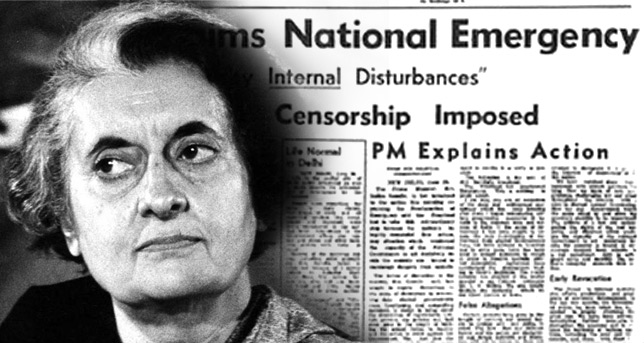CURRENT AFFAIRS
Get the most updated and recent current affair content on Padhaikaro.com
Types of Emergency
- IAS NEXT, Lucknow
- 01, Jan 2021

Part- XVIII of Indian Constitution deals with the Emergency provisions i.e. Articles 352 to 360. There are three types of Emergencies mentioned in the Constitution. The power of imposing all three types of Emergencies is vested upon the President of India. The concept of Emergency was borrowed from the Weimar Constitution of Germany. The three types are as follows –
- Article 352 – National Emergency
- Article 356 – President’s Rule
- Article 360 – Financial Emergency
Grounds for the Proclamation of Emergency
National Emergency
Grounds for the proclamation of National Emergency are as follows:
National Emergency
Article 352 deals with “Proclamation of Emergency” or “ National Emergency”. The President of India has the power to declare an Emergency in India or any part of India by making a Proclamation.
Under this Article, if the President is satisfied that a grave emergency exists in India due to which there is a threat to the security of the nation, he may declare Emergency on the grounds of-
- War
- External Aggression
- Armed Rebellion
The word “Armed Rebellion” was substituted for “Internal Disturbance” by the Forty-fourth Constitution Amendment Act, 1978.
National Emergency has been imposed three times in India so far. The time period in which this happened was from 1962-1977.
- An emergency was imposed at the time of Indo-China war by the then President of India Dr Sarvepalli Radhakrishnan on the ground of external aggression from October 26, 1962, to January 10, 1968.
IMPORTANT NOTES : External Aggression means when a country attacks another country without any formal declaration of war. It is a unilateral attack by any country towards another country. For example – If a country attacks India without any formal declaration of war, in such a scenario, the President of India may impose a National Emergency.
Again, an Emergency was imposed from December 3, 1971, to March 21, 1977, by the then President of India Mr V.V. Giri during the Indo-Pakistan war. The reason was the same as above i.e. external aggression.
The third Emergency was imposed due to a clash between Legislature and Judiciary. Mrs Indira Nehru Gandhi, the then Prime Minister of India with the permission of the then President Fakhruddin Ali Ahmed declared an emergency.
It was imposed for a period of 19 months from June 25, 1975to March 21, 1977.
The proviso of Clause 1 states that an Emergency may be proclaimed by the President even when there is no actual occurrence of war, external aggression, and armed rebellion. In this case, the President must be satisfied that there is an imminent danger.
Clause 2 states that another Proclamation may be issued to revoke and to make any variation in the previous Proclamation.
Clause 3 states that the President of India may declare an Emergency when Union Cabinet (Council of Minister headed by the Prime Minister) advice to him in writing.
State Emergency
Article 356 deals with State Emergency or President’s Rule in the State (“Provisions in case of Failure of Constitutional Machinery in States”).
The President of India has the power to proclaim State Emergency when he receives a report from the Governor of that particular State explaining that the situation in the State Government is such that they cannot carry out the Constitutional provisions.
President’s Rule has been imposed on the State of Jammu and Kashmir for six years and 264 days from January 19, 1990, to October 9, 1996.
The State has always been a target for many external elements. The Indian Government imposed President’s Rule to control the situation of Jammu & Kashmir which was facing a military threat from Pakistan.
Punjab was under the President’s Rule for 4 years and 259 days from June 11, 1987, to February 25, 1992.
The reason for imposing President’s rule in Punjab was the control of Khalistan Commando Forces which was a Sikh organisation which was involved in the genocidal attack on Hindus.
Till January 2018, the President’s Rule has been imposed 125 times in India. During Indira Gandhi’s regime, the President’s Rule was invoked for maximum time. The President’s Rule under her cabinet was imposed 35 times in various states.
The case S.R Bommai v. Union of India is a landmark case in respect of imposing President’s Rule in any State.
The case laid down the power of the Union Government in relation to the State Emergency under Article 356 of the Indian Constitution.
Judicial Review of the President’s Rule was made possible by this case. While giving the judgement, the court depended on Sarkaria’s Commission Report, 1987.
President’s Rule can be judicially reviewed and the President becomes answerable only when the Emergency is imposed in certain cases, which are:
- When there is Constitutional non-conformity by the State with the direction of Union
- When there is a political crisis in the State.
- When there is an internal subversion in the State
Financial Emergency
Article 360 deals with “Provisions as to Financial Emergency”. Financial Emergency is imposed by the President when there arises any situation which causes a financial threat to India or any part of India.
Financial Emergency has never been imposed in India. However, in 1990, the possibility of financial emergency emerged but the situation was controlled by the Indian Government as in July 1991 the Reserve Bank of India pledged 46.91 tonnes of Gold with Bank of England and Union Bank of Switzerland to raise $400 million.